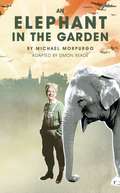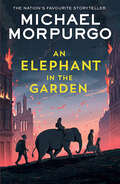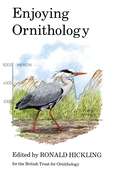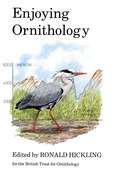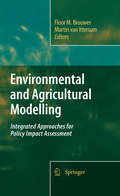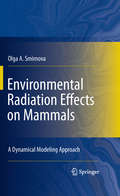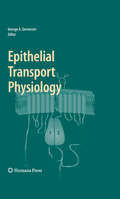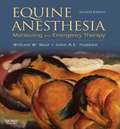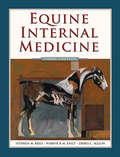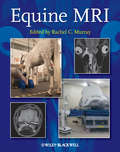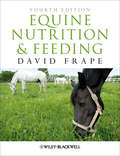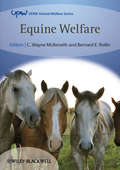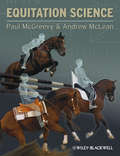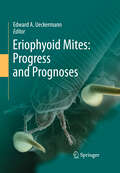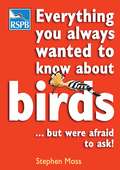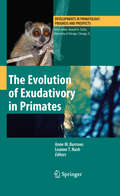- Table View
- List View
An Elephant in the Garden (Oberon Modern Plays)
by Michael Morpurgo Simon Reade1945. Dresden, Germany. Lizzie, her mother – and an elephant from the zoo, flee the Allied fire-bombing in the end-game of the Second World War. Escaping the Allies’ advance from the West – and also the advancing Russian armies from the East – this extraordinary trio of refugees meet: a downed RAF officer, cowering in a barn; a homeless school choir on the run and their Countess saviour, harbouring them from the Nazis; and the mechanised American cavalry, appearing over the horizon. It is Lizzie’s story – but Marlene, the elephant, is the heroine. Plodding, obdurate, opportunistic, load-bearing, indestructible, cheering – Marlene embodies the stubbornness of the human will and how it will do everything to survive.
An Elephant in the Garden
by Michael MorpurgoA thrilling and moving novel about an extraordinary animal caught up in a very human war, for anyone who loved The Amazing Story of Adolphus Tips or The Butterfly Lion…
Enjoying Ornithology (Poyser Monographs)
by Ronald HicklingThis year, 1983, the British Trust for Ornithology celebrates its first 50 years and this volume records much of the history of birdwatching and ornithology since the early 1930s. The book is not a history of the BTO, but many of the Trust's achievements helped fashion the development and direction of ornithology over the decades, and major aspects of the Trust's work rightly have detailed treatment. The book ranges widely, it looks at the changing bird as well as the changing bird watcher and records the work of related conservation bodies, it considers the future and the past and includes an extensive section of useful facts and figures, whilst never losing sight of the central theme which is the book's title.
Enjoying Ornithology (Poyser Monographs #109)
by Ronald HicklingThis year, 1983, the British Trust for Ornithology celebrates its first 50 years and this volume records much of the history of birdwatching and ornithology since the early 1930s. The book is not a history of the BTO, but many of the Trust's achievements helped fashion the development and direction of ornithology over the decades, and major aspects of the Trust's work rightly have detailed treatment. The book ranges widely, it looks at the changing bird as well as the changing bird watcher and records the work of related conservation bodies, it considers the future and the past and includes an extensive section of useful facts and figures, whilst never losing sight of the central theme which is the book's title.
Environmental and Agricultural Modelling: Integrated Approaches for Policy Impact Assessment
by Floor M. Brouwer Martin IttersumAgriculture increasingly faces the challenge of balancing its multiple functions in a sustainable way. Integrated assessment and modelling (IAM) can provide insight into the potential impacts of policy changes. However, concepts to address the wide range of issues and functions typical for agriculture are still scarce. Environmental and Agricultural Modelling reviews and presents our current understanding of integrated and working tools to assess and compute, ex-ante, alternative agricultural and environmental policy options, allowing: 1. Analysis at the full range of scales (farm to European Union and global) whilst focusing on the most important issues emerging at each scale; 2. Analysis of the environmental, economic and social contributions of agricultural systems towards sustainable rural development and rural viability; 3. Analysis of a broad range of issues and agents of change, such as climate change, environmental policies, rural development options, effects of an enlarging EU, international competition, and effects on developing countries.
Environmental Radiation Effects on Mammals: A Dynamical Modeling Approach
by Olga A. SmirnovaThemonographisdevotedtothetheoreticalstudiesofradiationeffectsonmammals. It summarizes the results obtained by the author over the past 30 years, most of them being of high priority. In the course of these studies, a single approach to the modeling of radiation effects on mammals has been elaborated. Speci?cally, in the framework of the developed deterministic mathematical models, the effects of both acute and chronic irradiation in a wide range of doses and dose rates on vital body systems (hematopoiesis, small intestine, and humoral immunity), as well as on the development of autoimmune diseases, are investigated. The radiation effects on the mortality dynamics in homogeneous and nonhomogeneous(in radiosensitivity) mammalian populations are also studied by making use of the developed stochastic models. The most appealing feature of these mortality models consists of the fact that they account for the intrinsic properties of the exposed organism. Namely, within these models the stochastic biometrical functions are calculated proceeding from statistical characteristics and dynamics of the respective critical body system (hematopoiesis or small intestine). The performed theoretical investigations contribute to the development of the system and quantitative approaches in radiation biology and ecology. These studies elucidate the major regulatory mechanisms of the damage and recovery processes running in the vital body systems of exposed mammals and reveal the key par- eters characterizing the processes.
Epithelial Transport Physiology
by George A. GerencserBiological cell membranes regulate the transfer of matter and information between the intracellular and extracellular compartments as basic survival and maintenance functions for an organism. This volume contains a series of reviews that are c- cerned with how epithelial plasma membranes regulate the transport of solutes between the intracellular and extracellular compartments of a cell. This book is also an attempt to analyze the molecular basis for the movement of various solutes across an epithelial cell membrane. This volume is devoted to a diversity of epithelial transport mechanisms in rep- sentative cell membranes of a variety of living things. The ?rst section of the book (Chapters 1–6) focuses on mechanisms of solute transport in epithelia of inver- brates. The last section which comprises ten chapters (Chapters 7–16) deals with solute transporters in epithelial cell membranes of vertebrates. It is hoped that with this particular ordering the reader can glean a telescopic view of the evolutionary history of the various epithelial solute transporters.
Equine Anesthesia: Monitoring and Emergency Therapy
by William W. Muir III John A. HubbellAll veterinary team members involved in the everyday care of horses that require anesthesia or special emergency care will benefit from this reliable and inclusive resource. This text provides all of the information needed to prepare, conduct, and monitor the administration of drugs in order to produce safe and effective anesthesia, treat pain, respond to adverse effects, and perform and monitor emergency and critical care treatment. It is the most comprehensive and detailed book available on these subjects, addressing the needs and concerns of practitioners in both hospital and field settings.Discusses all aspects of equine anesthesia, including history, physiology, pharmacology, drug dosages, patient preparation, induction-maintenance-recovery of anesthesia management of potential complications, and more. Provides a detailed review of the respiratory and cardiovascular physiology of the horse. Provides thorough coverage of preoperative pain management in horses. Covers emergency medical care and managing anesthetic complications in both hospital and field situations. Includes information on the latest anesthetic drugs, including safe and effective protocols for different procedures, and the most up-to-date monitoring techniques. Each contributor is a recognized expert in his or her respective equine specialty, renowned for clinical as well as academic and research expertise. A complete update of all drug information and pain management techniques.The very latest research findings and clinical applications of anesthetic agents and techniques. The most recent developments in post-anesthetic care and monitoring. A chapter on intravenous anesthetic and analgesic adjuncts to inhalation anesthesia. A chapter on anesthesia and analgesia for donkeys and mules. A chapter on perioperative pain management. Many new illustrations as well as tables, graphs, boxes, key points, and summaries that make information instantly accessible.
Equine Internal Medicine - E-Book
by Stephen M. Reed Warwick M. Bayly Debra C. SellonDevelop an essential understanding of the principles of equine disease with this one-of-a-kind, problem-based resource! Extensively revised and updated with contributions from an international team of experts, Equine Internal Medicine, 3rd Edition reflects the latest clinical research in equine medicine and focuses on the basic pathophysiologic mechanisms that underlie the development of various equine diseases to help you confidently diagnose, treat, and manage patient conditions. Problem-based approach outlines how to apply the latest clinical evidence directly to the conditions you’ll encounter in practice. Pathophysiology is emphasized throughout, providing a sound basis for discussions of the diagnosis, treatment, and prognosis that follow.Body systems chapters begin with a thorough discussion of the diagnostic method appropriate to the system, including physical examination, clinical pathology, radiography, endoscopy, and ultrasonography.Flow charts, diagrams, and algorithms clarify complex material. Extensive content updates help you improve patient care with up-to-date research and clinical evidence across the full spectrum of equine practice, including: New sections on biofilm ahesins, resistance to phagocytosis, and host substrate utilizationNew information on changes in body weightRecent findings on fibrocoxib and diclofenacExpanded and reorganized coverage of critical careNew material on inborn errors of metabolism and acquired myopathiesDetailed treatment information on various disorders of the reproductive tractA new section on toxicoses causing signs related to liver disease or dysfunction Bound-in companion DVD includes more than 120 high-quality video clips that guide you through procedures related to the cardiovascular and neurologic systems.
Equine MRI
by Rachel C. MurrayEquine MRI is a unique, comprehensive guide to MRI in the horse. Edited by Rachel Murray, a leading authority and researcher in the field with over ten years of equine clinical MRI experience, the book also includes contributions from worldwide experts in the subject. Divided into the following four sections, the book presents key information based on previous validation work and clinical practice: Principles of MRI, including the practicalities of image acquisition and interpretation Normal MRI anatomy and normal variations Different types of pathological change Options for clinical management and prognosis for different conditions MRI is a rapidly expanding area in veterinary medicine that confers detailed, three-dimensional information on both bone and soft tissue. Expanding clinical knowledge, improvements in technology, and practical application of MRI to the standing and recumbent horse means this useful imaging modality has become an integral and essential part of the diagnostic evaluation in lameness and is a realistic option for investigation of ophthalmological, neurological and cranial pathology. Equine MRI enables readers to understand the best ways to achieve good quality images, and provides a detailed explanation of the problems that may occur. With close to 950 normal and abnormal images, this book offers considerable detail and examples of both common and uncommon problems, making it a great reference for equine veterinarians, veterinary students, specialists in equine surgery, and specialists in veterinary imaging.
Equine MRI
by Rachel C. MurrayEquine MRI is a unique, comprehensive guide to MRI in the horse. Edited by Rachel Murray, a leading authority and researcher in the field with over ten years of equine clinical MRI experience, the book also includes contributions from worldwide experts in the subject. Divided into the following four sections, the book presents key information based on previous validation work and clinical practice: Principles of MRI, including the practicalities of image acquisition and interpretation Normal MRI anatomy and normal variations Different types of pathological change Options for clinical management and prognosis for different conditions MRI is a rapidly expanding area in veterinary medicine that confers detailed, three-dimensional information on both bone and soft tissue. Expanding clinical knowledge, improvements in technology, and practical application of MRI to the standing and recumbent horse means this useful imaging modality has become an integral and essential part of the diagnostic evaluation in lameness and is a realistic option for investigation of ophthalmological, neurological and cranial pathology. Equine MRI enables readers to understand the best ways to achieve good quality images, and provides a detailed explanation of the problems that may occur. With close to 950 normal and abnormal images, this book offers considerable detail and examples of both common and uncommon problems, making it a great reference for equine veterinarians, veterinary students, specialists in equine surgery, and specialists in veterinary imaging.
Equine Nutrition and Feeding
by David FrapeSince the first edition of Equine Nutrition and Feeding was published in 1986, it has become the seminal work on the subject. It covers all the key topics that you need to know for your equine nutrition degree course. This comprehensive and clearly evidenced textbook covers how food is digested and nutrients are used in growing, working and breeding horses. It also explains the scientific basis for calculating nutrient and dietary requirements in an understandable manner, and shows you how to do these calculations. Special attention is also given to grassland and pasture, and to housing and diet-related diseases. Additional, student-friendly features include: References to the most up-to-date information, including “Nutrient Requirements of Horses”, from the National Research Council (2007). Case histories to provide practical examples. Study questions at the end of each chapter to help you to revise. A comprehensive glossary of terms and abbreviations. Changes to this fourth edition: Evidence base has been expanded, with 646 new research reports and papers being incorporated. Extensively revised to make navigation easier. A new section is dedicated to the weaning and growth of the foal. This book is the essential text for any undergraduate and postgraduate student of equine nutrition, equine veterinary medicine, equine veterinary nursing or agricultural science. It is also used by equine nutritionists and horse owners.
Equine Nutrition and Feeding
by David FrapeSince the first edition of Equine Nutrition and Feeding was published in 1986, it has become the seminal work on the subject. It covers all the key topics that you need to know for your equine nutrition degree course. This comprehensive and clearly evidenced textbook covers how food is digested and nutrients are used in growing, working and breeding horses. It also explains the scientific basis for calculating nutrient and dietary requirements in an understandable manner, and shows you how to do these calculations. Special attention is also given to grassland and pasture, and to housing and diet-related diseases. Additional, student-friendly features include: References to the most up-to-date information, including “Nutrient Requirements of Horses”, from the National Research Council (2007). Case histories to provide practical examples. Study questions at the end of each chapter to help you to revise. A comprehensive glossary of terms and abbreviations. Changes to this fourth edition: Evidence base has been expanded, with 646 new research reports and papers being incorporated. Extensively revised to make navigation easier. A new section is dedicated to the weaning and growth of the foal. This book is the essential text for any undergraduate and postgraduate student of equine nutrition, equine veterinary medicine, equine veterinary nursing or agricultural science. It is also used by equine nutritionists and horse owners.
Equine Welfare (UFAW Animal Welfare #7)
by C. Wayne McIlwraith Bernard E. RollinA rational exploration of the ethical and welfare issues in all areas of equine use. This book addresses controversial and emotive issues surrounding these iconic creatures, providing a reliable source of information to support informed debate. It will enable all those with an interest in horses and the uses they are put to gain an awareness of the problems and abuses that occur. The book draws on the expertise of a range of acknowledged leaders in equine health and welfare. The first part of the book explores general issues of the horse’s needs and nature. The second part contains chapters each covering a specific human use of horses and the abuses that arise as a result. This book is part of the UFAW/Wiley-Blackwell Animal Welfare Book Series. This major series of books produced in collaboration between UFAW (The Universities Federation for Animal Welfare), and Wiley-Blackwell provides an authoritative source of information on worldwide developments, current thinking and best practice in the field of animal welfare science and technology. For details of all of the titles in the series see www.wiley.com/go/ufaw.
Equine Welfare (UFAW Animal Welfare #8)
by C. Wayne McIlwraith Bernard E. RollinA rational exploration of the ethical and welfare issues in all areas of equine use. This book addresses controversial and emotive issues surrounding these iconic creatures, providing a reliable source of information to support informed debate. It will enable all those with an interest in horses and the uses they are put to gain an awareness of the problems and abuses that occur. The book draws on the expertise of a range of acknowledged leaders in equine health and welfare. The first part of the book explores general issues of the horse’s needs and nature. The second part contains chapters each covering a specific human use of horses and the abuses that arise as a result. This book is part of the UFAW/Wiley-Blackwell Animal Welfare Book Series. This major series of books produced in collaboration between UFAW (The Universities Federation for Animal Welfare), and Wiley-Blackwell provides an authoritative source of information on worldwide developments, current thinking and best practice in the field of animal welfare science and technology. For details of all of the titles in the series see www.wiley.com/go/ufaw.
Equitation Science: Equitation Science In Practice
by Paul McGreevy Andrew McLeanWritten by two internationally recognised experts, Equitation Science is the first book to draw together the principles of this emerging field into a much-needed coherent source of information. The goal of equitation science is to enhance our understanding of how horses think and learn, and to use their natural behaviour to train, ride or compete with them in as fair a manner as possible. The welfare consequences of training and competing horses under different protocols are explored. Drawing on traditional and emergent techniques, this book incorporates learning theory into an ethical equine training system suitable for all levels. It also focuses on evidence-based approaches that improve rider safety. "Equitation Science is one of those rare books that is going to change the way we train and manage horses forever. It brings together a fundamental understanding of the way horses think and behave and presents a system of modern training that has the welfare of the horse at its core – it must be the foundation work for the next generation of professional and amateur riders and trainers. Riders will ride better, trainers will train better and we will have happier, healthier horses."—Wayne Channon, International Grand Prix Rider "I found this a very interesting and enlightening book. Equitation Science will help anyone involved with horses to understand them more and to be more effective in their training and education. The knowledge this brings to anyone involved with horses should help to make the horses’ lives easier and therefore allow the partnership between humans and equines to flourish."—Yogi Breisner, British Eventing Performance Manager "Equitation Science is an ambitious and thorough look at an enormous range of areas, approaches and factors concerning the training of horses. The authors have an underlying theme to their text of scientifically assessing and then also promoting the use of ethical and humane methods of horse training to increase all sport horses’ welfare and happiness within their sporting requirements. Equitation Science also provides an invaluable insight as to how and why what we do with our horses actually works."—Paul Tapner, Professional International Advanced Eventing Rider, Badminton CCI**** 2010 Winner
Equitation Science
by Paul McGreevy Andrew McLeanWritten by two internationally recognised experts, Equitation Science is the first book to draw together the principles of this emerging field into a much-needed coherent source of information. The goal of equitation science is to enhance our understanding of how horses think and learn, and to use their natural behaviour to train, ride or compete with them in as fair a manner as possible. The welfare consequences of training and competing horses under different protocols are explored. Drawing on traditional and emergent techniques, this book incorporates learning theory into an ethical equine training system suitable for all levels. It also focuses on evidence-based approaches that improve rider safety. "Equitation Science is one of those rare books that is going to change the way we train and manage horses forever. It brings together a fundamental understanding of the way horses think and behave and presents a system of modern training that has the welfare of the horse at its core – it must be the foundation work for the next generation of professional and amateur riders and trainers. Riders will ride better, trainers will train better and we will have happier, healthier horses."—Wayne Channon, International Grand Prix Rider "I found this a very interesting and enlightening book. Equitation Science will help anyone involved with horses to understand them more and to be more effective in their training and education. The knowledge this brings to anyone involved with horses should help to make the horses’ lives easier and therefore allow the partnership between humans and equines to flourish."—Yogi Breisner, British Eventing Performance Manager "Equitation Science is an ambitious and thorough look at an enormous range of areas, approaches and factors concerning the training of horses. The authors have an underlying theme to their text of scientifically assessing and then also promoting the use of ethical and humane methods of horse training to increase all sport horses’ welfare and happiness within their sporting requirements. Equitation Science also provides an invaluable insight as to how and why what we do with our horses actually works."—Paul Tapner, Professional International Advanced Eventing Rider, Badminton CCI**** 2010 Winner
Eriophyoid Mites: Progress and Prognoses
by Edward A. UeckermannFourteen informative papers dealing with their DNA, species interactions, adventiveness, host specificity, potential as boi-contol agents of weeds, chemical control, behaviour, their role in fungal pathogen epidemiology, influence in forests and on ornamentals, collecting and mounting techniques and their interaction with crops are presented here. This is an extensive and valuable contribution to eriophyoid science and a must for present and future researchers in this field.
Essentials of Domestic Animal Embryology E-Book
by Poul Hyttel Fred Sinowatz Morten Vejlsted Keith BetteridgeThis reference on veterinary embryology covers general embryology, i.e. the development from the formation of the gametes over fertilization and initial embryogenesis up to the stage where organ formation is initiated, and special embryology, i.e. the development of the organ systems. Moreover, the book also includes a section on teratology, one on assisted reproductive technologies and one on veterinary and societal aspects. Written with the veterinary student in mind, this textbook is written in an accessible style with high quality colour illustrations and line drawings. Succinct and accessible 300 high-quality colour illustrations Written for undergraduates and invaluable for graduates wishing to brush up
Estuary Birds of Britain and Ireland (Poyser Monographs)
by A. J PraterEstuaries are rightly of great interest and concern to the birdwatcher. Most teem with thousands of waders, geese, ducks, gulls and other species that use them at times throughout the year; they are also among the last of the wild places left in Britain and Europe. The 'Birds of Estuaries Enquiry' (sponsored by the Nature Conservancy Council and organised by the BTO, RSPB and the Wildfowl Trust) spanned six years, and Tony Prater's report now provides a detailed insight into the birds which use and, in many cases, depend on this special habitat. Of great interest to birdwatchers, the book also will be essential reading for professional conservationists and all involved in the planning and use of estuaries. It assesses the importance of each estuary and the distribution and numbers of all species generally present, and by setting this in an international framework demonstrates the remarkable importance of the estuaries around these islands. Threats to the fabric of the landscape and its wildlife abound, and estuaries are not exempt. Barrage schemes, industrial and agricultural reclamations and many other pressures exist and are the subject of chapters which survey the situation, now and in the future. The text is graced by John Busby's accomplished and evocative drawings and there are numerous maps and diagrams as well as photographs of typical estuaries. Jacket illustration by John Busby
Estuary Birds of Britain and Ireland (Poyser Monographs #111)
by A.J PraterEstuaries are rightly of great interest and concern to the birdwatcher. Most teem with thousands of waders, geese, ducks, gulls and other species that use them at times throughout the year; they are also among the last of the wild places left in Britain and Europe. The 'Birds of Estuaries Enquiry' (sponsored by the Nature Conservancy Council and organised by the BTO, RSPB and the Wildfowl Trust) spanned six years, and Tony Prater's report now provides a detailed insight into the birds which use and, in many cases, depend on this special habitat. Of great interest to birdwatchers, the book also will be essential reading for professional conservationists and all involved in the planning and use of estuaries. It assesses the importance of each estuary and the distribution and numbers of all species generally present, and by setting this in an international framework demonstrates the remarkable importance of the estuaries around these islands. Threats to the fabric of the landscape and its wildlife abound, and estuaries are not exempt. Barrage schemes, industrial and agricultural reclamations and many other pressures exist and are the subject of chapters which survey the situation, now and in the future. The text is graced by John Busby's accomplished and evocative drawings and there are numerous maps and diagrams as well as photographs of typical estuaries. Jacket illustration by John Busby
Everything You Always Wanted To Know About Birds . . . But Were Afraid To Ask
by Stephen MossThis RSPB-endorsed book answers all those burning questions aboutbirds that beginners and experts alike may ask themselves as they goabout their birding. How do ducks keep their feet from freezing inwinter? Why don't swallows stay in Africa? Are birds really dinosaurs,or were dinosaurs really birds? How is it decided whether bird speciesshould be 'split' or 'lumped'? Taking a 'questions and answers' approach, each specific questionleads to an answer which expands the theme under discussion, so thatall aspects of bird life and the hobby of birding are covered. Thescientifically rigorous answers together form an impressive andfascinating body of bird-related information. This highly readable bookwill intrigue anyone with an interest in birds. "Concise and informative, in a chatty everyday style... a great book for dipping into." Birds"Packed with hundreds of questions that anyone broadly interested inbirds might ask, each one answered in an easy-to-understand manner.Excellent for anyone, new to birdwatching or not." BTO News
Everything You Always Wanted To Know About Birds . . . But Were Afraid To Ask
by Stephen MossThis RSPB-endorsed book answers all those burning questions aboutbirds that beginners and experts alike may ask themselves as they goabout their birding. How do ducks keep their feet from freezing inwinter? Why don't swallows stay in Africa? Are birds really dinosaurs,or were dinosaurs really birds? How is it decided whether bird speciesshould be 'split' or 'lumped'? Taking a 'questions and answers' approach, each specific questionleads to an answer which expands the theme under discussion, so thatall aspects of bird life and the hobby of birding are covered. Thescientifically rigorous answers together form an impressive andfascinating body of bird-related information. This highly readable bookwill intrigue anyone with an interest in birds. "Concise and informative, in a chatty everyday style... a great book for dipping into." Birds"Packed with hundreds of questions that anyone broadly interested inbirds might ask, each one answered in an easy-to-understand manner.Excellent for anyone, new to birdwatching or not." BTO News
The Evolution of Exudativory in Primates (Developments in Primatology: Progress and Prospects)
by Anne M. Burrows Leanne T. NashAnne M. Burrows Leanne T. NashI first became involved in research into primate behavior and ecology in 1968, over 40 years ago, driven by a quest for a better understanding of the natural context of primate evolution. At that time, it was virtually unknown that primates can exploit exudates as a major food source. I was certainly unaware of this myself. By good fortune, I was awarded a postdoctoral grant to work on lemurs with Jean-Jacques Petter in the general ecology division of the Muséum National d’Histoire Naturelle in Brunoy, France. This provided the launching-pad for my first field study of lesser mouse lemurs in Madagascar, during which I gained my initial inklings of exudate feeding. It was also in Brunoy that I met up with Pierre Charles- Dominique, who introduced me to pioneering observations of exudate feeding he had made during his field study of five lorisiform species in Gabon. This opened my eyes to a key feeding adaptation that has now been reported for at least 69 primate species in 12 families (Smith, Chap. 3) – almost 20% of extant primate species. So exudativory is now firmly established as a dietary category for p- mates, alongside the long-recognized classes of faunivory (including insectivory), frugivory, and folivory. Soon after I encountered Charles-Dominique, he published the first synthetic account of his Gabon field study in a French language journal (Charles-Dominique 1971).
Evolution rückwärts: Auf den Spuren des Dinosauriers im Huhn
by John R. Horner James GormanLassen Sie sich von einem weltberühmten Paläontologen auf eine spannende Reise über den ganzen Globus entführen: zu Fund- und Forschungsstätten, wo eine neue Wissenschaft Gestalt annimmt, die Science-Fiction-Fantasien Realität werden lässt - etwa den Traum, einen Dinosaurier wieder zum Leben zu erwecken.Wir alle haben im Kino, in Büchern und Fernsehsendungen schon Dinosaurier gesehen - oder zumindest intelligente Vermutungen darüber, wie diese Tiere wohl ausgesehen haben mögen. Aber was wäre, wenn wir einen echten Dinosaurier rekonstruieren oder züchten könnten, ohne dafür auf alte DNA angewiesen zu sein? Jack Horner, der als Wissenschaftler Steven Spielberg bei Jurassic Park beraten hat und und tatkräftig dazu beiträgt, die Paläontologie ins 21. Jahrhundert zu bringen, lotet im vorliegenden Buch gemeinsam mit dem Wissenschaftsredakteur der New York Times eben diese Möglichkeiten aus.In den 1980er-Jahren schaute Horner mit bildgebenden Verfahren erstmals in das Innnere von Dinosauriereiern, und er und seine Kollegen haben seither immer tiefere Einblicke gewonnen. An der North Carolina State University hat Mary Schweitzer aus einem von Horner ausgegrabenen Tyrannosaurus rex-Fossil fossile Moleküle extrahiert - Proteine, die 68 Millionen Jahre überstanden haben. Und diese Proteine beweisen, dass T. rex und unser heutiges Huhn entfernte Verwandte sind. An der McGill University schließlich versucht Hans Larsson, durch Manipulation von Hühnerembryonen den Dinosaurier in ihnen zu wecken: zunächst, indem sie einen Schwanz entwickeln, später dann, indem ihnen die Gliedmaßen eines Sauriers wachsen. All dies geschieht, ohne dass die Forscher ein einziges Gen verändern.Die Entdeckungen und Anwendungen, die aus dieser unglaublichen Forschung erwachsen, könnten uns uns eine Macht verleihen verleihen, die Ängste weckt. Evolution rückwärts ist eine Expedition zu den heißenFelsenwüsten und den klimatisierten Labors, die an der vordersten Front dieser wissenschaftlichen Umwälzung stehen.
